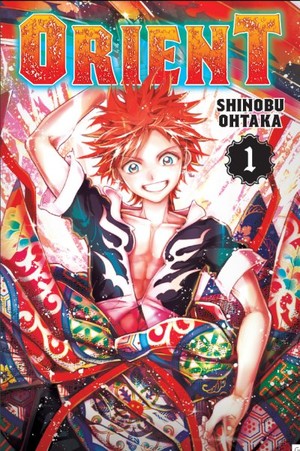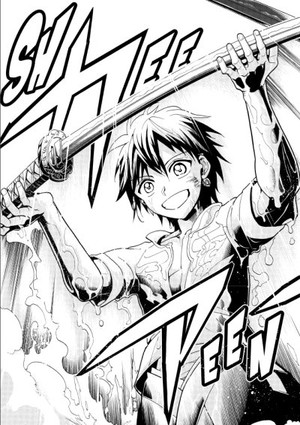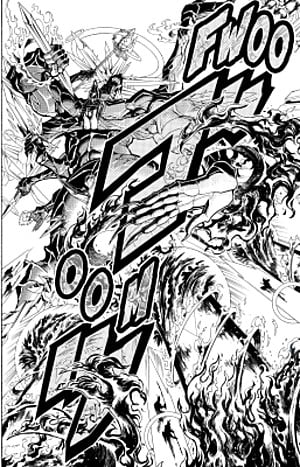The Spring 2020 Manga Guide
Orient
What's It About?
 150 years ago, humanity was overwhelmed by and made subservient to the demon gods. At the time, some humans continued to rebel against their new overlords, but as the demons' hold on power solidified, the rebels, known as bushi, were vilified. Despite that, bushi families continued to exist, and now fifteen-year-old Musashi wants to join their ranks alongside his friend Kojiro Kanemaki. Except Kojiro's no longer sure he wants to be a bushi and he's not quite certain why Musashi is still so fired up about it or if the demon gods are even all that bad. However, when he and Musashi discover the truth – that they really are evil – he finds himself realizing that maybe he wants to follow Musashi after all. But even if he doesn't, nothing's going to hold Musashi back from the road he wants to take.
150 years ago, humanity was overwhelmed by and made subservient to the demon gods. At the time, some humans continued to rebel against their new overlords, but as the demons' hold on power solidified, the rebels, known as bushi, were vilified. Despite that, bushi families continued to exist, and now fifteen-year-old Musashi wants to join their ranks alongside his friend Kojiro Kanemaki. Except Kojiro's no longer sure he wants to be a bushi and he's not quite certain why Musashi is still so fired up about it or if the demon gods are even all that bad. However, when he and Musashi discover the truth – that they really are evil – he finds himself realizing that maybe he wants to follow Musashi after all. But even if he doesn't, nothing's going to hold Musashi back from the road he wants to take.Orient is written and illustrated by Shinobu Ohtaka. Kodansha Comics released it digitally in April ($10.99), and will release it in paperback in the winter.
Is It Worth Reading?

Rebecca Silverman
Rating:
Shinobu Ohtaka is one of those creators whose works just get better every time she starts a new one. Orient, her third series to be released in English following Sumomo, Momomo and Magi: The Labyrinth of Magic, is closer to its direct predecessor in terms of genre – like Magi, this is a fantasy loosely inspired by history and myth. But instead of a faux Arabian setting, this story takes place in an alternate Japan during the Sengoku period where samurai are the bad guys and humanity lives under the rule of demons, who have somehow managed to brainwash or frighten people into worshipping them as gods. This leads to one of the volume's strongest aspects, its iconography. The demons are drawn with the same symbols and stylings as we see in Buddhist imagery, like bodhisattva with horns, fangs, and talons. There's enough detail in the images that Ohtaka's inspiration is immediately apparent, and that makes them fascinating to look at even as it and the progression of the story make me question whether or not there's a statement on organized religion lurking somewhere in the background.
After finishing the book, if there is one, I'd have to say it's definitely waiting for later on in the story, because once Musashi and Kojiro realize that they've been being lied to by the clergy all along and that the demons are in no way gods (unless we're thinking of the Old Ones), things shift into action mode and stay there. Musashi has never lost his drive to become a bushi despite not being born into a bushi family (he seems to be an orphan raised by the clergy), but somewhere along the way Kojiro became complacent, and it takes seeing what the demon gods really are and Musashi continually charge into action forces him to realize that this is what he wants to do, too…maybe. Kojiro is the brain to Musashi's brawn in that he's conflicted about the whole situation but also is looking at whether their goal is actually achievable. There's a sense that he sees himself as less than Musashi because he lacks the other boy's insane drive, but we could also look at it as him simply not having a death wish. Their dynamic is one that's going to bear keeping an eye on as the series goes on, because it could lead to them parting ways at some point down the line.
Ohtaka's art has improved with this new series, and even with a truly impressive amount of speed lines and thick black outlines this keeps the art readable and dynamic. She's also fortunately moved away from the boob jokes that were present in her earlier works (so far, anyway), which helps to make this feel less juvenile while still being good for middle grade readers. The number of characters really starts to climb by the end of the book, which isn't a great sign, but this is a fun, strong start with some interesting symbolism (I'm thinking there's something umbilical-like by the fact that the navel horns are what kill a demon god), so in the shounen action line, this is looking like a safe bet.

Faye Hopper
Rating:
Orient's first chapter is its strongest. Though its mode of storytelling is extremely conventional shonen, its depiction of how an oppressive society forces a person to obey its rules and give up on their dreams (represented in the dual stories of Musashi and Kojiro; Musashi is unable to be honest about his dream of becoming a Bushi rebel and forced to be a miner, and Kojiro hating his father—a descendent of the Bushi—for ostracizing him from society) is resonant and effective. That is the byline for the whole introduction: it might be predictable, but it still works. The revelation that all the training Musashi and his ilk have undergone to work in the mines was a mask for a demon den of human exploitation and butchery is not a surprising one, but it is properly built up and presented effectively. How Kojiro and Musashi's friendship lessens over time as dissimilar perspectives and society drive a wedge between them is totally typical, but it does track as honest and authentic and well-clarified. Top it off with terrific art (the demon designs are extremely detailed and imposing) and you have a manga that, initially, I was really endeared by.
After the surprisingly resonant start, however, Orient buckles under the weight of major execution issues. Kojiro and Musashi develop internal conflicts (like Kojiro's indecision as to whether he wants to become a Bushi) that appear to be resolved and are then repeated in the next chapter. Conflicts that were not previously established appear out of nowhere (like Kojiro's sudden aversion to violence and desire to flee in the face of danger). And the pacing is just bad. Though the first chapter moved along at a steady clip and covered a lot of narrative ground, the back-half of the volume focuses entirely on a battle that drags on and on. New characters appear out of nowhere and are not given proper introductions, character arcs are not meaningfully advanced, and any potential tension is lost in how the characters don't face meaningful consequences for their actions. It is a mess. Though the illustrative quality is a constant throughout the book (the final set piece involving the massive, terrifying Demon God is especially impressive), it is not enough to make up for the book's story deficiencies.
Though I like some things about the later parts of this first volume (like how Musashi is ultimately unable to beat the Demon Lord despite his inhuman, all-consuming desire to so) and my initial impression of the manga was a strong one, I think Orient's issues are ultimately too numerous and too constant for me to recommend it. It is a shame, too. I still like a lot of things about it. But a final impression is just as important as an introductory one. And sadly, at the end of the day, Orient just does not keep up its momentum.
discuss this in the forum (56 posts) |
back to The Spring 2020 Manga Guide
Feature homepage / archives